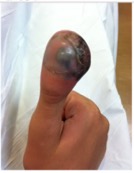Osborn Waves
History of present illness:
An 88-year-old female was found lying prone and unresponsive outside of her home with an unknown downtime. She was intubated in the field by medics and brought to the emergency department (ED). In the ED, she had a core temperature of 78 degrees Fahrenheit (°F) with a heart rate of 21 beats per minute. Active rewarming and resuscitation were started and serial electrocardiograms (ECGs) were performed; two hours later, her core temperature had increased to 86°F.
Significant findings:
The initial ECG shows a junctional rhythm with Osborn waves (or J point elevations/J waves) in the lateral precordial leads, as well as the limb leads (Image 1). The second ECG, 49 minutes later, shows an improving ventricular rate and Osborn wave height decrease of approximately 50% (Image 2).
Discussion:
Differentiating between mild, moderate and severe hypothermia can help guide resuscitation efforts in these patients. Patients with mild hypothermia have core temperatures between 90-95°F and present with shivering, tachypnea, and tachycardia. Those with moderate hypothermia have core temperatures between 82-90°F and present with muscle rigidity, altered mental status, bradycardia and hypoventilation. Severe hypothermia is defined as a core temperature below 82°F. These patients are often comatose, hypotensive, and apneic.1
Patients with primary hypothermia and cardiac stability who have been treated with active external and minimally invasive rewarming techniques have a rate of neurologically intact survival of approximately 100%.2 For patients with primary hypothermia and cardiac instability or cardiac arrest, extracorporeal membrane oxygenation (ECMO) may be the best treatment option. The rate of neurologically intact survival for patients with cardiac arrest treated with extracorporeal rewarming is approximately 50%. If ECMO or cardiopulmonary bypass is not available and transport to a facility with these capabilities is not possible, circulation should be supported with CPR while the patient is rewarmed with an alternative internal rewarming technique.
Topics:
EKG, Osborn wave, J wave, ECG, cardiology, environmental, hypothermia, ECMO.
References:
- Wong CS, Chen KC, Wang TL. Clinical aspects of hypothermia. Ann Disaster Med. 2004;2:2.
- Brown DJ, Brugger H, Boyd J, Paal P. Accidental hypothermia. New England Journal of Medicine. 2012; 367(20):1930-1938. doi: 10.1056/NEJMra1114208




